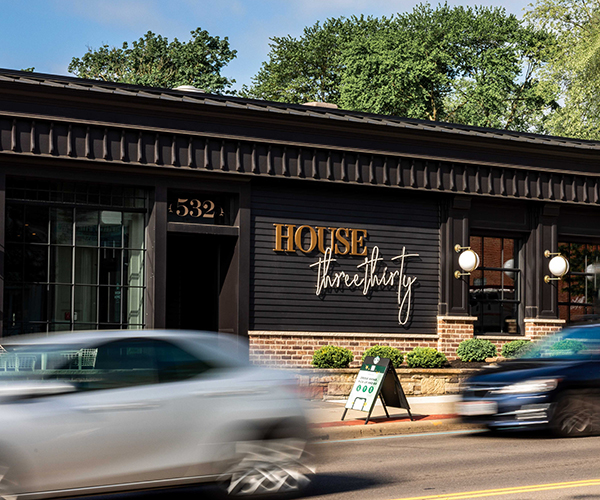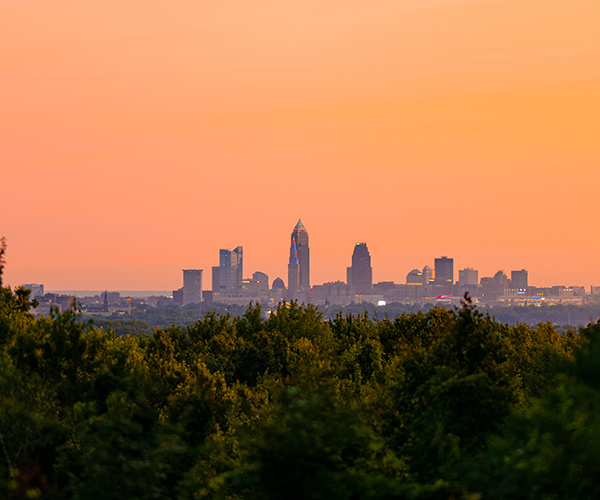There's a chestnut in some old history books that describes Ohio's pre-settlement wilderness as the sort of place where a squirrel could climb a tree in Ashtabula County and walk to Cincinnati without ever touching the ground.
A vast closed-canopy forest marched south from the Lake Erie shore, meeting the edge of the Appalachian Plateau where Cedar Hill is today and mingling with the open prairies as it stretched toward what is now the Indiana border.
It was home to populations of elk, timber wolves, black bears and woodland bison. It was the Ohio that Moses Cleaveland saw in the summer of 1796, when he led a surveying crew here to pace out a 10-acre public square.
The next 100 years changed all that. Trees were cleared in favor of farming. Rampant deforestation left the state 85 percent bare by 1915. Two years later, the Ohio legislature called for the formation of local park districts and empowered them to buy, protect and even develop open land in an effort to both conserve the natural ecosystem and set aside recreational spaces for Ohioans to enjoy.
Today, there are secluded, wooded spots in the Cleveland Metroparks' 20,000-acre "Emerald Necklace" that can make you forget that miles of highways, housing developments and strip malls surround you. You can get equally lost in the 33,000 acres of federally protected land in the Cuyahoga Valley National Park and in metropolitan park districts that have been established in Lake, Lorain, Medina, Portage, Geauga and Summit counties since the 1920s.
What we haven't been so good about is giving our parks room to breathe. Year after year, we've migrated deeper into rural areas, turning open fields and forests into housing and shopping centers. One estimate claims we're occupying 30 percent more land than we did 15 years ago without a corresponding increase in population. A map drawn in 2001 that identifies protected land in seven Northeast Ohio counties illustrates the reason for concern. Thin green trails that identify existing parklands meander through vast blocks of property that have already been developed or are in private hands. There's not a whole lot left to protect.
And those charged with preserving the last vestige of Northeast Ohio's wilderness must balance two very different and difficult battles. One is combating invasive plants and animals while maintaining native ones. The other is educating the public that decisions about land use just beyond the parks' borders, good or bad, will have both natural and economic effects likely to echo for decades to come.
Tom Stanley has learned to be patient. The recently retired chief of natural resources for the Cleveland Metroparks remembers his youthful, unrealistic optimism when he signed on to help guide Northeast Ohio's largest metropolitan park system 34 years ago.
"I was always gung-ho that we could make this happen quickly," he recalls. "You think if you just work a little harder it will go faster."
But if you plant 5,000 seedlings on a 50-acre field, your efforts don't ensure there will be a tall stand of trees on the property a century later. Stanley says it probably wouldn't look much different than a 50-acre field left untouched. Even the term "natural-resource management" makes him uncomfortable.
"You can't really force nature in a direction it doesn't want to go," he cautions. "We like to use the word 'nudge.' "
Nudge, indeed. Consider the force needed to influence 14 reservations covering nearly 20,000 acres — roughly the same area as 640 Cleveland Browns Stadiums — that are home to more than 900 plant, 500 animal and thousands of insect and invertebrate species.
Park biologists and naturalists must balance a good offense, making conditions just right for native plants and animals, with a merciless defense that involves identification and elimination of problematic non-native organisms. Usually, these latter are plant, animal or insect species that have no native predators or controls in Ohio's woodlands and wetlands — and were brought here from other parts of the world by humans.
Part of the management process is identifying what's gone from Ohio's natural spaces forever, such as elk, bears and chestnut trees, and determining how their absence will hinder the development of a more native ecosystem. Assuming everything goes well after that, it will still take 150 to 200 years to convert a farm field into the sort of thick, native forest that once covered the state.
"Those are the challenges of managing open space from a conservation view," Stanley says. "We have to keep things in control that are too common and try to get things that are uncommon to come back through natural processes."
Deer is one native animal species that has become much too common in recent years. Monitoring by the Cuyahoga Valley National Park indicates that Northeast Ohio's deer population has more than doubled in the past decade. But the deer explosion is not that difficult to trace. The suburban housing boom has pushed the animals into an ever-shrinking corner of the wild that borders back yards, golf courses and utility corridors. They can easily live in this type of patchwork environment. The problem is, they thrive in it.
"That whole checkerboard of different kind of habitats is actually more favorable to deer in terms of what they need than a traditional, closed-canopy forest," explains Stanley. "So our mixed habitats of today can actually support a higher deer density than historically."
But those densities are now dangerously high, according to CVNP wildlife biologist Lisa Petit.
"Deer densities are now up to 130 [animals] per square mile," she says. "That is six or seven times higher than what's been shown in other places to cause severe damage to the ecosystem."
Voracious eaters, deer will "eat themselves out of house and home," Stanley says, stripping the forest floor of vegetation and, in some cases, causing grave setbacks to the restoration of a natural system. The Cleveland Metroparks has tried to stem this problem in several ways. The first has been harvesting deer during the winter months in park reservations that are overrun. The park system has killed 1,841 deer since 1998 in what has proven a controversial move when serving a public raised on "Bambi." The second method is chemical contraception. But that program is currently studying only 100 does, not enough to make even a dent with an estimated 750,000 deer roaming the state.
"In some places, literally nothing is growing between about 4 1/2 feet and the ground with the exception of a couple things they don't eat," Stanley says. "Some of the irony there is some of the things they don't eat are the things we don't want anyway, like garlic mustard."
Non-native species are the other half of the park system's balancing act. Plant invaders such as garlic mustard, phragmites and glossy buckthorn choke habitats to the point that native organisms no longer can or want to live there.
The Cleveland Metroparks' Rocky River Reservation, for example, is home to large pockets of garlic mustard, a close-to-the-ground plant with scalloped, kidney-shaped leaves and small white flowers. It dominates the same soil, nutrients and water that Ohio's native wildflowers need to survive, eventually pushing them out completely. Since it has no natural predators or controls, the only way to get rid of garlic mustard is for humans to uproot the plant and cart it out of the park for disposal. Stanley says 20 such invasive organisms are on the park's "hit list." Taming them is a matter of persistent maintenance.
"What we do is prioritize the places that have the best wildflowers in them," he explains. "It will be a higher priority than an area with less diversity. Because even if we could magically get rid of all the garlic mustard in the park today, it would be on its way back tomorrow."
The offices of the Cuyahoga Valley National Park are located in five small yellow houses near the intersection of Vaughn and Riverview roads. The buildings served as offices for the Jaite Mill Co., which once operated a now-crumbling papermaking facility along the Cuyahoga River.
The only national park in Ohio, the federal government designated 33,000 acres of the Cuyahoga Valley for protection in 1974, as a way to shore up public support for larger park systems in wilder areas of the country such as Wyoming and Alaska, which the vast majority of city dwellers never get to see firsthand.
"Congress and people wanted to bring the National Park System into more urban areas," explains William J. Carroll, deputy superintendent for the CVNP. "There was a practical reason for that. This is where the voters are. There was a calculated political decision to bring parks to the people."
So, 30 years ago, Congress identified a large chunk of the Cuyahoga Valley as a "national recreation area." (It was deemed a "national park" by an act of Congress in October 2000.) But what makes our national park unique is that more than 3,400 acres of land within the park's boundaries are still in the hands of private owners. Meanwhile, a smattering of historic sites — such as the Jaite Paper Mill, the old Boston Store and some small working farms — have given the park a cultural and educational mission that employees must balance with its natural one.
And for the past 30 years, new homes and businesses have slowly crept up to the park's border. That growth has also pushed pollutants into the national park's centerpiece: the Cuyahoga River. "We're far from seeing it cleaned up to the extent that we would consider it a healthy river," Carroll says.
What's going on outside the park's boundaries has also played a huge role in the river's recovery. The Cuyahoga is already much cleaner today than it was when the park was created. That cleanup has helped beavers, which were nearly eradicated from the state, to migrate back into Northeast Ohio's watersheds. At Beaver Dam, near Ida and Riverview roads in the CVNP, visitors routinely gather to watch beaver, herons and other waterfowl. But when the federal government designated the property a national recreation area in 1974, what is a now natural wetlands area was the final resting place for several junked cars.
Carroll warns that the CVNP still must keep a close eye on development just outside the park's borders. It always threatens to increase vehicle traffic, change wildlife migration and force more runoff pollution into the river.
"Non-point-source pollution occurs when land is converted from a natural ecosystem and there's asphalt put on the ground," Carroll explains. "Storm-water runoff that is carried into the tributaries and eventually into the river greatly concerns us."
It's a common practice for the CVNP to target open areas adjacent to the park that have yet to be developed but very likely will be in the near future, according to Carroll. The plan is not to buy the land, but to convince those who do to work with the CVNP to help minimize stress on the park and the river caused by new construction.
"It's only a matter of time before these areas are lost if they're not purchased by another jurisdiction for protection," Carroll says. "So we want to engage those communities to say, 'If and when these lands are acquired, we would like to be involved,' and get their support to help protect the national park and river.
That means urging builders to plan for proper storm-water retention and land buffers that protect the parks' ecosystems from damage and the river from pollution. He points to a construction project currently under way near the park's common border with the city of Cuyahoga Falls as a situation in which the CVNP has stepped up to advocate for protection of the park and its resources.
But it's also clear that once Carroll and his colleagues have made their case, the matter is very much out of their hands. The irony is that controlling the toll humans take on our park systems should be easier than wrangling with natural forces. But getting people to make those conservation-minded decisions is often an uphill battle. As Carroll says, "We've made our concerns known to them. We'll see what happens."
When Steve Madewell joined the Lake Metroparks staff 15 years ago, he began documenting the plants and animals on the verge of disappearing from the park system's 7,000 acres. His crew found more than 100 in all. Only two species had ever been identified as threatened populations prior to that survey.
"It's not that we only had two at the time," explains Madewell, now the park system's deputy director. "They were just the only two we knew about. It was kind of like running a warehouse without knowing what's on the shelves."
Like many of the region's metropolitan park districts, Lake Metroparks is younger and smaller than the Cleveland Metroparks' expansive "Emerald Necklace" or the nearly 9,000-acre Metro Parks, Serving Summit County that was founded in the 1920s. Like most metropolitan park systems, it is funded by a tax levy (two in Lake County's case) and 90 percent of its property has been kept in a natural state.
In the late 1990s, Madewell and a host of his counterparts from other regional park systems formed the Northeast Ohio Regional Parks Consortium to identify long-term opportunities to link existing park systems and create a common vision.
"Our whole region hasn't grown in population numbers, but the amount of land that's been consumed to provide housing and shopping and transportation for the same number of people has really grown dramatically," Madewell explains. "I believe park districts have a very important role in offsetting the impacts associated with this sort of growth pattern."
The three years of collaboration resulted in a sweeping new vision released in September 2001 that calls for creating more than 1,000 miles of new trails linking cities and park systems, opening new greenway corridors that connect to the Lake Erie shoreline and preserving areas around the region's waterways to help filter out contaminants.
"With the direction land use is going, there is an ongoing need for us to remain committed to trying to protect the streams and waterways," Madewell says. "I don't believe we've done as good a job as we need to."
He contends the region's park systems haven't collectively done enough to ensure the health of their important streams and rivers. A wish list of land the various districts hope to protect illustrates his point. There are long stretches of the Black River, Rocky River, Cuyahoga River and Grand River that have been earmarked by the Northeast Ohio Regional Parks Consortium as "potential conservation corridors," but that, as of today, are still unprotected.
The ambitious plan would require the generosity of individuals, businesses and the region's leaders over the course of decades. Park systems already routinely court private landowners for conservation easements that will ensure the land is never developed even if it remains in private hands. After that, it would take local communities — which invest millions of dollars in roads, buildings, bridges and sewer projects each year — to see the importance of setting aside money for the preservation of open space.
"You come to a place like Northeast Ohio and it does have its issues in terms of the economy," remarks the CVNP's Carroll, who moved here from Atlanta two years ago. "But one of the strong selling points for knowledge workers — people who are interested in a great quality of life — is the natural resources in the park system."
Madewell concurs that our region's biggest selling point may not be our cost of living or our diverse ethnic neighborhoods or our cultural institutions. Maybe it's also having a quiet space where you can unwind under a canopy of trees no more than a 15-minute drive from your front door, no matter where you live.
"An old forest speaks of stability," he says. "In the time and world we live in, people respond to having an opportunity to come into a park and feel, when they come back there 20 years from now, there's going to be part of their community that's still in place."



